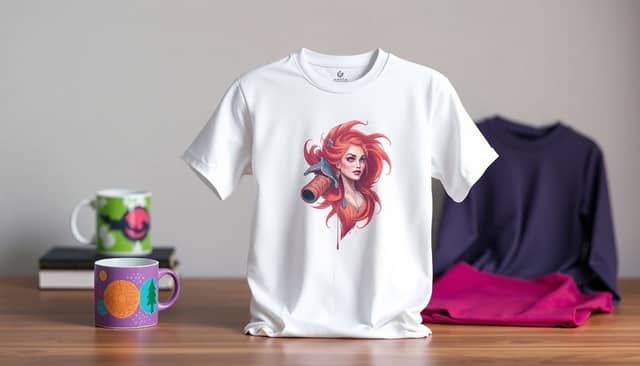Table of Contents
Finding a great print-on-demand service can feel overwhelming—you’ve got plenty of choices, and each promises the moon. And let’s face it, choosing wrong could mean disappointing products, slow shipping, or unhappy customers.
Don’t panic, though. You’re in luck—this guide simplifies every tough decision. Stick around, and you’ll find exactly what you need, from reviews of the leading POD companies to helpful tips on picking providers that match your brand’s style perfectly.
Ready? Let’s jump right in.
Key Takeaways
- Printful offers reliable quality, easy integration with Shopify and WooCommerce, and a growing product range—ideal if you want variety and consistent service.
- If profit margins matter most, go with Printify. Many sellers see profit margins of 40-50%, with transparent pricing upfront.
- For eco-conscious sellers, SPOD is a great choice since about 30% of their items are expected to be eco-friendly by late 2025.
- Always order samples first. This lets you confirm product quality, check print methods (DTG for cotton apparel, sublimation for mugs or sportswear), and evaluate durability.
- Pick a POD provider that integrates well with your current ecommerce platform to keep things smooth and easy.

Best Print-on-Demand Services in 2025 (Ranked and Reviewed)
Print-on-demand has become a huge business—it’s projected to reach around $12.96 billion in value by the end of 2025, growing fast at nearly 27% per year. So if you’re thinking about starting an online store or simply adding products to your website without the hassle of inventory, finding the right service matters a lot.
Let’s talk about some of the top services out there right now. Printful continues to lead the market, and there’s a good reason why: they offer high-quality products, simple integration with popular ecommerce platforms like Shopify and WooCommerce, and solid shipping speeds. As of 2025, Printful has added an impressive 2,550 new items to their catalog within the past year alone, giving you tons of product variety.
Next in line, we’ve got Printify, another top choice, especially if you’re looking to maximize profit margins. Sellers using Printify average between 40-50% profit margins, and certain products can even yield higher margins. That’s huge compared to regular retail, making it perfect for sellers who are budget-conscious but still want high quality.
Lastly, SPOD (Spreadshirt Print on Demand) is pushing ahead in terms of sustainability. They’re expected to use eco-friendly materials for around 30% of their products by the end of 2025. This is a great pick if your customers value ethical sourcing and eco-conscious brands.
Step-by-Step Guide to Selecting the Right Print-on-Demand Provider
Picking out a good print-on-demand provider doesn’t have to feel overwhelming. You’re basically looking for a partner that’ll consistently deliver quality products on time and work seamlessly with your existing website or ecommerce store. But let’s break this down step-by-step:
Step 1: Know Your Niche and Products
First up, clearly define what you’ll be selling. If you focus on custom kids’ books or journals, pick a provider like Amazon KDP or Lulu that specializes in those specific niches. For clothing, you’d benefit more from platforms like Printful or Printify because of their extensive apparel selections.
Step 2: Order Samples to Check Quality
You can’t tell how good a product will look from pictures on a screen—trust me, I’ve learned this the hard way. Always place sample orders. Check the fabric quality, color accuracy, product durability, packaging and print sharpness to avoid issues down the road.
Step 3: Examine Profit Margins and Pricing Transparency
Check how transparent the provider is about costs and margins. Watch out for hidden fees or add-ons (like printing labels or custom inserts), because these can quickly eat up your margins if you’re not careful. Providers such as Printify clearly display all costs upfront, helping you confidently price your products.
Step 4: Evaluate Integrations and Ease-of-Use
Choose a provider compatible with your current ecommerce setup. If your shop is built using Shopify, WooCommerce or Etsy, companies like Printful and SPOD offer easy plug-ins and straightforward user interfaces that simplify adding new products.
Step 5: Check Reviews and Community Support
Hop into Facebook groups, Reddit threads, and forums to see what actual store owners say about their POD provider experiences. Real-life feedback gives you insights you’d never get from a company website alone.
Compare Shipping Speeds and Costs Between Top Print-on-Demand Companies
Nobody likes customers leaving your site because shipping is either too slow or too expensive. Let’s quickly compare some popular services to identify who delivers fast and affordable.
Printful: Offers reliable shipping globally, typically delivering US orders within 3-7 business days. International shipping may take up to 10-15 days, but prices are clearly presented upfront.
Printify: Shipping costs and speeds depend on your chosen printing partner (Printify uses multiple producers). Usually, products ship domestically (US) within 3-8 business days. Choosing US-based printing options dramatically reduces both shipping costs and transit times.
SPOD (Spreadshirt): Boasts some of the fastest turnarounds in the industry—48-hour production time on most orders. Standard US shipping averages 3-6 business days, with international shipments typically arriving within 7-14 business days. A fantastic option if speed is crucial for your business.
One tip I’ve learned over time: always clearly state shipping times on your product pages—it’s an easy way to manage customer expectations and avoid disappointment or frustration later.

Understand Product Quality and Print Methods Offered by POD Platforms
If you don’t get product quality right, customers won’t come back, simple as that.
So, how do you make sure your POD provider delivers top-notch items consistently?
First things first: familiarize yourself with the primary types of printing methods used in the industry.
The two most common methods are direct-to-garment (DTG) printing and sublimation printing.
DTG printing is perfect for detailed designs on cotton apparel, because the ink is directly applied into the fabric, leading to vibrant colors and a smooth feel.
On the other hand, sublimation printing suits polyester-based items (think mugs, phone cases, or athletic wear) and results in super-durable prints because the inks fuse directly into the material rather than staying on the surface.
Before committing to a POD provider, order samples to put their quality to the test.
Most providers, like Printful and Printify, allow easy sample ordering at discounted rates.
When samples arrive, look closely at stitching, fabric weight, color vibrancy, and print durability after washing.
Finding quality that’s up to your standards is a critical step to ensure you’re confident in the product your customers receive.
Tips for Matching Your POD Provider to Your eCommerce Store Platform
Choosing a print-on-demand provider that integrates effortlessly with your eCommerce platform helps save a ton of headaches down the line.
For popular platforms like Shopify or WooCommerce, providers such as Printful and SPOD offer painless setup with free plugins, simple data syncing, and even automatic order fulfillment.
If you’re selling via Etsy or Amazon, double-check how smoothly the integration is handled—every company handles these platforms a bit differently.
Make sure you find a provider with great integration support, minimizing any technical troubles down the road.
A quick tip: set up test listings from your chosen provider before launching officially to make sure everything works smoothly.
Lastly, don’t forget to check customer support and documentation from your POD provider—good tech support is a lifesaver if problems pop up.
How to Choose a Print-on-Demand Service Based on Your Brand Style and Customization Options
A huge part of running a successful POD business is making your brand stand out—so customization really counts.
If your brand is built around sleek, designer-quality aesthetics, consider POD providers like Gelato, known for high-end materials, custom packaging options, and consistency across global locations.
Brands that rely heavily on unique, artistic designs should probably look toward providers who offer deeper customization of print areas—giving you total creative control over your final product.
If your audience eats up personalized products—like custom books, notebooks, or coloring books—then you’ll need providers specializing in these niche categories, for example, Lulu’s excellent book printing and binding services.
Always consider if your POD provider allows custom inserts, neck labels, or packaging.
These personal touches might seem small, but they definitely add up and help customers remember you.
Recommendations for Print-on-Demand Services by Product Type and Audience
Not all POD services excel equally at everything, so here’s what’s solid right now for different product types and audiences:
Apparel and Fashion: Printful leads in reliable DTG printing quality, fast turnaround, great apparel variety, and consistent quality reviews from real sellers.
Stationery and Books: For planners, journals, or niche notebooks, choosing a book-focused POD platform like Lulu or Amazon KDP makes more sense—they specialize specifically in book printing and distribution.
Home Decor Items (Canvases, Posters): Gelato excels in wall art printing due to excellent print clarity and quick, local printing facilities worldwide, making shipping faster and more affordable.
Sustainable Products: SPOD offers tons of eco-friendly options, great for brands that emphasize ethical shopping, as sustainability continues trending higher in popularity every year.
For brands targeting specific niches, like children’s books or personalized journals, you might want to check out this helpful post on becoming a children’s book author as it might help you choose your platform accordingly.
Next Steps: Ordering Product Samples and Testing POD Providers
After narrowing providers down to your top picks, it’s time to get your hands on actual product samples before committing fully.
Ordering samples isn’t just to check quality—this step allows you to experience packaging, unboxing, and overall first impressions your customers will receive.
Remember, consistent quality across multiple orders is also important, so place orders from different printing locations or at different times to ensure stability.
Monitor how your POD providers handle shipping notifications, trackability, and delivery speed as well.
To see how well customer support works, contact their help facilities or live chat with basic inquiries and gauge the responsiveness and usefulness of their responses.
Lastly, show those samples to trusted friends, family, or potential buyers and ask for brutally honest feedback—that outsider view can really help you catch small things you might overlook yourself.
With samples tested and everything looking good, you’ll be ready to confidently launch your POD products and start growing your store.
FAQs
Review their product selection, customization choices, and design tools. Order samples to verify print quality and check if product aesthetics align closely with your brand’s message, values, and target audience preferences before making a decision.
Most popular print-on-demand providers offer direct integrations with major eCommerce platforms like Shopify and Etsy. Check available integrations on the provider’s website or test their apps and plugins before committing to ensure easy setup and smooth management processes.
Visit each provider’s shipping information page to assess rates, delivery times, and fulfillment locations. Place test orders to your target regions to verify actual turnaround times and final costs, ensuring transparency and reliability before partnering.
Yes, ordering product samples allows you to verify print clarity, fabric/material quality, color accuracy, durability, shipping conditions, and packaging. Doing this ensures the provider meets your standards and helps avoid customer dissatisfaction in the future.



